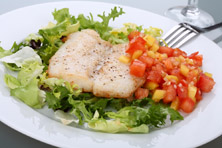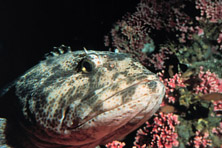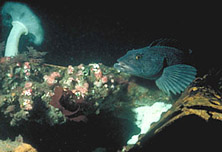Lingcod (Ophiodon elongatus)
- Lingcod populations are rebuilt and are no longer subject to overfishing.
- The rebuilding of lingcod stocks was completed several years ahead of schedule through gear restrictions and fishery closures.
- Lingcod is a good source of low-fat protein and is high in vitamin B12 and selenium. For more on nutrition, see Nutrition Facts. (USDA)
- Close to 20% of the lingcod sold in the U.S. is imported from Canada; the rest comes from U.S. fisheries.
|
 |
 |
 |
 |
| Nutrition Facts |
| Servings 1 |
| Serving Weight
100 g |
 |
| Amount Per Serving |
 |
| Calories 85 |
 |
| Total Fat |
1.06 g |
 |
| Total Saturated Fatty Acids |
0.197 g |
 |
| Carbohydrate |
0 g |
| Sugars |
0 g |
| Total Dietary
Fiber |
0 g |
 |
| Cholesterol |
52 mg |
 |
| Selenium |
36.5 mcg |
 |
| Sodium |
59 mg |
 |
| Protein |
17.66 g |
 |
|
 |
 Scientist releasing tagged lingcod in South Puget Sound.
Scientist releasing tagged lingcod in South Puget Sound.
|
 |
Did you know?
Contrary to its name, the lingcod is not a cod, but rather a member of the greenling family, native only to North Pacific waters off the west coast of North America.
Lingcod are visual predators, feeding primarily by day.
Many lingcod grow to a large size; a 30-pound fish is not rare, and giants up to 80 pounds are reported from time to time.
|
|
| |
 |
|
Lingcod in the Pacific Ocean near Alaska. The lingcod is nicknamed "buckethead" because of its enormous head that looks too big for its body.
|
 |
|
Females lay large egg masses in crevices and under ledges in shallow near-shore habitats during winter and spring. The females leave and males guard the nest of white embryos for 8 to 10 weeks until the eggs hatch.
|
|
Sustainability Status
Biomass: Biomass for the stock off the west coast (Washington to California) is 60% above the biomass that supports Maximum Sustainable Yield (BMSY).
Overfishing: No
Overfished: No
Fishing and habitat: Lingcod are caught commercially through five main gear types: bottom trawls, handlines, otter trawls, set nets, and set lines. Lingcod are taken by recreational fishermen from boats, docks, and shore, as well as by spear-fishing divers. Restrictions on bottom trawl gear help protect rocky habitats where lingcod reside.
Bycatch: There is bycatch of other groundfish and non-groundfish species; the Pacific Coast Groundfish Fishery Management Plan (FMP) includes measures to reduce bycatch of all species.
Aquaculture: There is currently no commercial aquaculture of lingcod in the U.S.
|
Science and Management
Lingcod support important commercial and recreational fisheries throughout their range, from the Gulf of Alaska to Baja California. The State of Alaska manages lingcod fisheries in both state and federal waters off Alaska. In the Pacific Fishery Management Council (PFMC) management zone (from California to Washington), lingcod are managed through the Pacific Coast Groundfish Fishery Management Plan (FMP). Genetics analysis and tagging studies suggest that the fish found within the area managed by the PFMC are of one intermingling stock, but for management and assessment purposes the stock is divided into two units, Lingcod-North and Lingcod-South. Management measures include trip limits, recreational size and bag limits, commercial size limits, seasonal closures, and gear restrictions. Currently, all sectors of the groundfish fishery are limited by the need to rebuild several groundfish species that have been designated as overfished. The overall groundfish harvest has been significantly reduced because of the slow reproduction rate and small stock size of some species. Catch of lingcod has increased steadily in recent years, likely due to the stock's rebuilding.
|
Life History and Habitat
Life history, including information on the habitat, growth, feeding, and reproduction of a species, is important because it affects how a fishery is managed. Fast-growing, short-lived species usually respond to management measures more quickly than slower growing, long-lived species. Lingcod grow relatively quickly and are fully mature between the ages of 8 and 10, so each generation replaces aging or harvested fish in just a few years. As a result, fishery managers can alter fishing regulations and, subsequently, offset natural and human induced fluctuations in lingcod biomass more quickly than for slower growing fish.
- Geographic range: From Kodiak Island in Gulf of Alaska to Baja California; center of abundance near British Columbia and Washington
- Habitat: Larval lingcod are epipelagic, living in the top layer of the ocean. Juveniles settle on sandy bottom near eelgrass or kelp beds. Young adults and adults move to rocky habitats or seaweed, kelp, and eelgrass beds where prey is abundant.
- Life span: About 20 years
- Food: Larvae are zooplanktivores, feeding on tiny floating animals including all life stages of copepods (small crustaceans), as well as small amounts of amphipods (small, shrimp-like crustaceans), euphausiids (krill), and decapod (crustaceans such as lobster and crab) larvae. Small juveniles living near the bottom prey upon copepods, shrimp, and other small crustaceans. Larger juveniles shift to clupeids and other small fishes. Adults feed primarily on bottom fishes (including smaller lingcod), squid, octopi, and crab.
- Growth rate: Lingcod grow rapidly; they reach approximately 12 inches in their first year. Females grow faster than males after 2 years.
- Maximum size: 5 feet
- Reaches reproductive maturity: Males begin maturing at about 2 years and 19.7 inches, whereas females mature at 3 or more years and 30 inches. In the northern extent of their range, fish mature at an older age and larger size.
- Reproduction: The fecundity (reproductive potential) of females ranges from about 40,000 to 500,000 eggs. In late fall, male lingcod aggregate and become territorial in areas suitable for spawning. Mature females are rarely seen at the spawning grounds, and it is assumed that they move into spawning areas for only a brief time to deposit eggs. Females lay large egg masses in crevices and under ledges in shallow near-shore habitats during winter and spring. Males guard the nest sites for 8 to 10 weeks until the eggs hatch.
- Spawning season: December through April
- Spawning grounds: Spawning generally occurs in waters 10 to 33 feet below mean low water over rocky reefs in areas of swift current.
- Migrations: Males are generally considered non-migratory and territorial, remaining close to the place of their births at depths from 30 to 1,000 feet. However, migrations over 62 miles have been recorded for sexually immature fish, and evidence suggests a seasonal onshore movement by females associated with spawning.
- Predators: Gastropods (mollusks), crabs, echinoderms (such as starfish, brittle stars, and sea urchins), spiny dogfish, and cabezon eat lingcod eggs. Predators of juveniles and adults include marine mammals, sharks, and larger lingcod.
- Commercial or recreational interest: Both
- Distinguishing characteristics: Nicknamed buckethead, the lingcod has an enormous mouth and jaws set on a head that looks too big for its body.
|
Role in the Ecosystem
Lingcod larvae are zooplanktivores, feeding on all life stages of copepods, as well as small amounts of amphipods, euphausiids, and decapod larvae. Small demersal juveniles prey upon copepods, shrimp, and other small crustaceans. Larger juveniles shift to clupeids and other small fishes. Adults feed primarily on demersal fishes (including smaller lingcod), squids, octopi and crabs. Lingcod are a visual predator, feeding primarily by day. Eggs are eaten by gastropods, crabs, echinoderms, spiny dogfish, and cabezon. Juveniles and adults are eaten by marine mammals, sharks, and larger lingcod.
|
Additional Information
Market name: Lingcod
Vernacular names: Cultus cod, Blue cod, Buffalo cod, Ling
|
Biomass
 Biomass refers to the amount of lingcod in the ocean. Scientists cannot collect and weigh every single fish to determine biomass, so they use models to estimate it instead. These biomass estimates can help determine if a stock is being fished too heavily or if it may be able to tolerate more fishing pressure. Managers can then make appropriate changes in the regulations of the fishery. A rebuilding strategy was implemented by the Pacific Fishery Management Council in 1999 for lingcod along the west coast, with a goal for the stock to be rebuilt by 2009; it included an increase in the minimum size limit, seasonal closure of recreational and commercial fisheries, and a gear restriction limiting the number of hooks. The 2005 lingcod stock assessment for the west coast stock, consisting of the Northern and Southern areas, showed that the stock has been rebuilt to a level exceeding statutory requirements, several years ahead of schedule. Biomass refers to the amount of lingcod in the ocean. Scientists cannot collect and weigh every single fish to determine biomass, so they use models to estimate it instead. These biomass estimates can help determine if a stock is being fished too heavily or if it may be able to tolerate more fishing pressure. Managers can then make appropriate changes in the regulations of the fishery. A rebuilding strategy was implemented by the Pacific Fishery Management Council in 1999 for lingcod along the west coast, with a goal for the stock to be rebuilt by 2009; it included an increase in the minimum size limit, seasonal closure of recreational and commercial fisheries, and a gear restriction limiting the number of hooks. The 2005 lingcod stock assessment for the west coast stock, consisting of the Northern and Southern areas, showed that the stock has been rebuilt to a level exceeding statutory requirements, several years ahead of schedule.
Note: Lingcod biomass is presented as spawning stock biomass, the amount of lingcod in the population that can reproduce.
Note: The biomass estimates presented do not include Alaska biomass estimates. North and South refer to the two management units off the West Coast. There are currently no sufficiently accurate abundance estimates for lingcod in Alaska.
Landings
 Landings refer to the amount of catch that is brought to land. Commercial landings of lingcod off the West Coast have been variable and declined steeply in the mid-1990s. Stricter management in the late 1990s limited harvest of lingcod, as the stock was deemed overfished in 1999. In 2005, the stock had recovered and the rebuilding plan was removed. Landings refer to the amount of catch that is brought to land. Commercial landings of lingcod off the West Coast have been variable and declined steeply in the mid-1990s. Stricter management in the late 1990s limited harvest of lingcod, as the stock was deemed overfished in 1999. In 2005, the stock had recovered and the rebuilding plan was removed.
Note: U.S. commercial landings off the West Coast are presented in the graph.
Biomass and Landings
 Are landings and biomass related? Landings are dependent on biomass, management measures in the fishery, and fishing effort. Although the lingcod stock has been declared rebuilt, landings remain low because all sectors of the groundfish fishery are currently limited by the need to rebuild several groundfish species that have been designated as overfished. The overall groundfish harvest has been significantly reduced because of the slow reproduction rate and small stock size of some species. Are landings and biomass related? Landings are dependent on biomass, management measures in the fishery, and fishing effort. Although the lingcod stock has been declared rebuilt, landings remain low because all sectors of the groundfish fishery are currently limited by the need to rebuild several groundfish species that have been designated as overfished. The overall groundfish harvest has been significantly reduced because of the slow reproduction rate and small stock size of some species.
Data sources:
Biomass from Assessment of Lingcod for the Pacific Fishery Management Council in 2005
Landings from NOAA's National Marine Fisheries Service (NMFS) Annual Commercial Landing Statistics using "LINGCOD" as Species and "PACIFIC" and "ALASKA" as State
|
Important Dates
Note: The following dates relate to Pacific coast lingcod, not Alaska.
1980 – Recreational bag limit of 5 fish set
1981 – 22-inch size limit enacted for recreational fishing efforts
1982 – Pacific Coast Groundfish Fishery Management Plan (FMP) implemented
1985 – Commercial landings peaked at 3,129 metric tons (6.9 million pounds)
1994 – Amendment 6 to the Pacific Coast Groundfish FMP implements a license limitation program for vessels in the groundfish fishery
1995 – Trip limits established for commercial trawls
1998– Recreational bag limit reduced to 3 lingcod; minimum size requirements increased to 24 inches
1999– Lingcod declared overfished; Amendment 16-2 includes rebuilding plan for lingcod to be rebuilt by 2009; recreational bag limit reduced to 2 lingcod
2000 – Rebuilding strategy includes minimum size limit increase to 26 inches, seasonal closure of recreational fishery, and gear restriction limiting the number of hooks
2005 – Lingcod stock assessment showed stock rebuilt to a level exceeding statutory requirements; Amendment 16-4 removes lingcod rebuilding plan from the FMP
2005 – Essential fish habitat closures put in place to protect groundfish habitat; 3 types of closed areas: bottom trawl closed area, bottom contact closed area, and bottom trawl footprint closure
|
Notes and Links
General Information:
NOAA's National Marine Fisheries Service (NMFS) Sustainability Species Identification for Lingcod
Pacific Fishery Management Council Background on Groundfish
Pacific Fishery Management Council Groundfish Fact Sheet
Fisheries Management:
Pacific Fishery Management Council Pacific Coast Groundfish Fishery Management Plan and Amendments
Stock Assessments:
Assessment of Lingcod for the Pacific Fishery Management Council in 2005
|
| |
|



